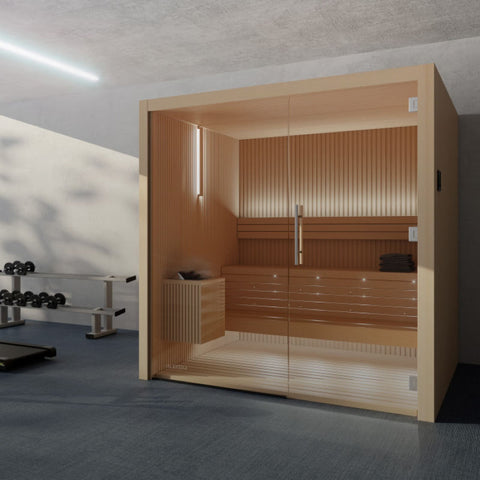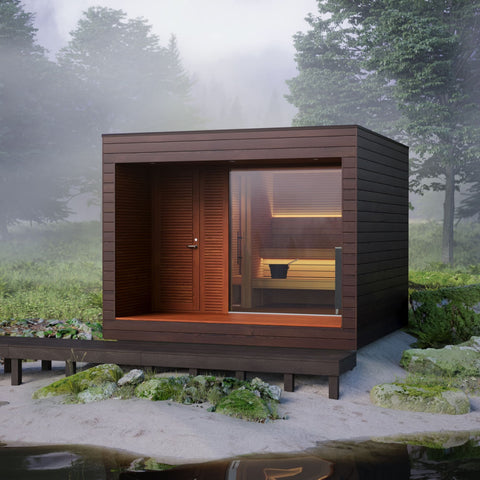Everything You Need to Know About Preparing for an In-Home Sauna Installation
So, you’ve decided to install a sauna at home. Now your future oasis joins the ranks of 2.5 million saunas built into businesses and homes in Finland, and roughly one million installed across the US.
It’s a great idea! Before you take the next steps, there are a few factors that need to be determined first. We sat down with our sauna sales manager, Rory, to compile a list of some of the most important things to consider to prep your home for a sauna installation.
The First Decisions to Make About Your In-Home Sauna
Traditional or Home Infrared Sauna
First things first, there’s deciding what kind of sauna you want — will it be a traditional or infrared sauna?
Traditional Finnish saunas should be heated to at least 170 degrees, oftentimes they’re heated up to 190. They’re unique because you have the option to pour water over hot rocks, releasing steam and humidity into the air. Because of the water element, a traditional sauna will have a humidity level between 20 and 40%.
On the contrary, home infrared saunas run at a much lower temperature than your traditional Finnish sauna. And unlike a traditional sauna, heat penetrates the body through near and far infrared wavelengths to elevate your body’s core temperature.
In either environment, you'll receive the many health benefits of a sauna, from inflammation reduction to collagen production to stress relief. For most people, the decision between choosing a traditional or infrared sauna simply comes down to a matter of preference. You can enjoy high heat for shorter intervals or sit in less abrasive temperatures for longer stints. Whatever you decide, we encourage you to try both and see what you like before making your investment.
Indoor vs. Outdoor Home Sauna
Once you’ve decided on what kind of sauna you want, the next step is to figure out where to place it. You really can’t go wrong between installing it indoors or outdoors — it’s more a matter of personal preference and what you think you’ll use most.
On the whole, indoor saunas are typically built free-standing or put directly into the infrastructure of your home. You’ll see them commonly placed in home gyms, master bathrooms, basements, or home spas. If you’re building a new home, you may choose to build a custom sauna directly into your home, or on the contrary, if you think a move may be in your future, a free-standing (modular) sauna is convenient and can still be relatively easy to move. Here’s our Cala Glass cabin as an example. It’s a modular home steam sauna that fits up to 3 people:

Cala Glass Cabin $5,950
Outdoor saunas have been gaining popularity in recent years and are a great addition to your backyard pool, or a complement to your outdoor shower. Since you don’t have a space constraint like you do with being indoors, outdoor saunas have a whole spread of customizable options and size variations. Keep in mind outdoor saunas do tend to be a bit more expensive, but if you’re looking to create a calming, outdoor oasis for your home, an outdoor sauna could be the perfect fit for you. Barrel saunas like our SaunaLife G11 are all the rage these days.

The SaunaLife G11 is a great example of a barrel sauna. $13,900.00
Whatever option you choose, just make sure it’s accessible and fits your lifestyle so you get as much use out of it as you want.
4 Steps to Prep for Installing Your Sauna at Home
Now that you know a little more about what sauna to choose and where it might live in your home, we’re going to go through some of the ways to get your home ready for installation.
01. Check the electrical
How you’re going to power your sauna is a critical question that needs to be addressed early on.
Usually, a home sauna requires 240 volts and a 30-60 amps dedicated circuit. Your home sauna will need a reliable electrical source to operate properly and accommodate the necessary power, so we recommend talking to an electrician first to see if what you want to do is actually possible.
02. Sizing requirements: What are the different sizes of saunas?
With an outdoor home sauna, you have more flexibility with spacing. But with an indoor sauna, the size of your unit matters greatly. The width and height of your sauna unit need to easily fit inside the room of your house that you’re planning on installing it in. Our saunas come in a range of sizes, from two-seaters to six-seaters. You can pick one to fit your bathroom, bedroom, or even your poolside.

The SaunaLife X2 can fit neatly in your bedroom. $4,990.00
You’ll also need to decide how many people you want to have using your sauna at any given time. If your unit is going to be used by one person, the sauna can be much smaller than, say, one you want to be used by your 4-person family together. The bottom line is, build an in-home sauna for how you think you’d use it in your everyday life.
03. Choosing the best material for your sauna
A sauna is more than just wood and a heater or a stove. A lot of materials work together to deliver the optimum experience: maintaining consistent temperatures within, controlling moisture levels, and ensuring the comfort and safety of users.
When selecting materials for your in-home sauna, consider the overall aesthetic, your personal preferences, the specific characteristics of each material, and how they will perform in the high heat and humidity of a sauna environment. Always ensure materials are safe for high-temperature environments and that any adhesives, sealants, or finishes used are non-toxic and sauna-safe.
Wood (interior and benches)
Wood is the most common material used in sauna construction due to its excellent heat insulation properties, natural feel, and ability to withstand the high temperatures and humidity of a sauna. It is also the largest component of your sauna. Different types of wood offer various benefits:
Cedar: Naturally immune to rot, decay, and insects, cedar has a pleasant aroma and does not absorb heat excessively, making it comfortable for seating surfaces.
Hemlock: Light-creamy to white, this wood is straight grain with a fine to medium texture, and resistant to warping and cracking.
Spruce: Often used in traditional Finnish saunas, spruce is light in color and has a tight grain. It’s perfect for cool and dry climes, but can also do well in humid environments with proper care and ventilation.
Aspen: A good choice for those with sensitivities, as it is hypoallergenic and does not emit a strong odor or resin.

The benches and lumbar supports in our SaunaLife G2 are made of velvety Aspen. $4,990
Insulation
Proper insulation is crucial for a sauna to maintain high temperatures efficiently. Materials like fiberglass or rock wool (also called mineral wool) are often the go-to choices for walls and ceilings.
Fiberglass, cost-effective and flexible for installation, performs well thermally but falls short in moisture and fire resistance compared to rock wool.
Rock wool, on the other hand, has superior moisture handling, fireproofing capabilities, and slightly higher insulation values. Despite being denser and somewhat more challenging to install, its ability to retain insulative properties when wet makes it a preferred choice for saunas.
Flooring
The flooring should be water-resistant and easy to clean. Options include:
- Concrete: Durable and easy to clean, but may require a drain for water runoff.
- Ceramic tiles: Water-resistant and available in various styles, but they can be slippery and cold underfoot.
- Vinyl: Waterproof and comfortable to walk on, use only if it is rated for high temperatures.
- Heater: The choice of heater depends on the type of sauna (traditional vs. infrared) and the size of the space. For traditional saunas, electric, wood-burning, or gas heaters are suitable. Infrared saunas require specific infrared panels.

Huum Drop Electric Sauna Heater Set $1,924.00 to $3,192.00
Lighting
Use lighting fixtures rated for high temperatures and humidity. LED lights are a popular choice due to their low heat emission and long lifespan.
0.4 Customizing your sauna at home
In-home saunas offer a multitude of opportunities for customization. With your new sauna, you can pick the heater you want and determine the overall design of your home sauna. We use products like Huum sauna heaters, SaunaLife barrel saunas, and Cabin Sauna Kits (to give you an idea of customization options) to outfit your finished product.
One of our most luxurious pre-assembled saunas, the five-seater Natura, comes with a terrace!
When we talked to our sales manager, Rory, about this topic, he had a few pieces of advice to share:
“There’s a sauna out there for every person, from high-tech to modest and everything in between. In my opinion, the best sauna you can build is a simple one. Some people tend to get really excited and want to go crazy on details, but for most people, building a sauna that’s simple is a better return on investment, and they’ll get more use out of it.
But like we’ve said before, customization all comes down to your preference and vision for your home sauna.”

Our Auroom Natura Outdoor Cabin Sauna is packed with great features. $51,650.00
If you’re feeling inspired to put a sauna in your home or you want to learn more about the process, reach out to our sauna expert, Rory! You can fill out our form here.Ready to Get Started on Your Home Sauna Installation?
If you’re feeling inspired to put a sauna in your home or you want to learn more about the process, reach out to our sauna expert, Rory! Contact us here.




